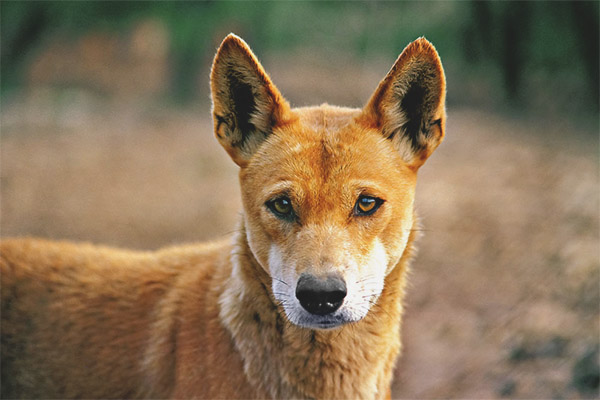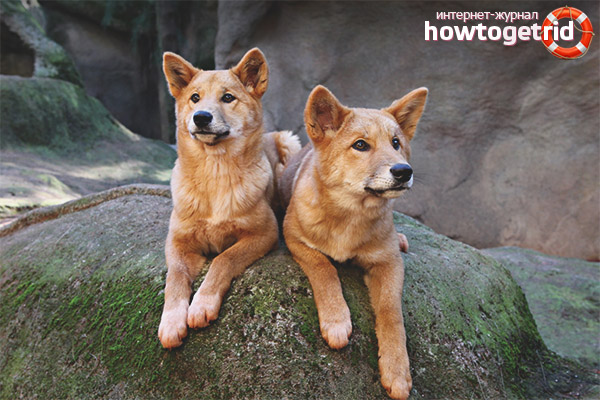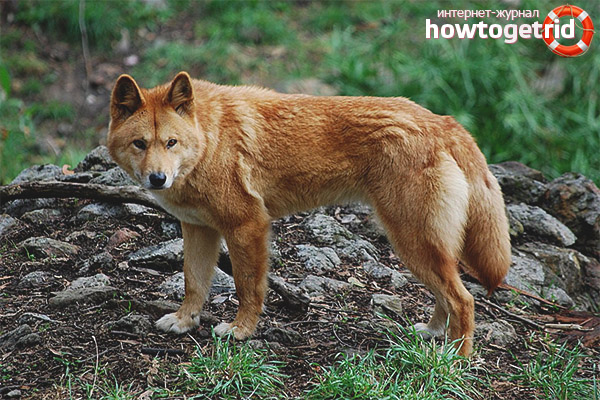The content of the article
By dingo is meant a single dog of the second-wild type. It belongs to the genus of wolves and members of the canine family. Today, these animals are considered one of the most popular in Australia. Dogs are distinguished by high intellectual abilities and quick wits. They have a deep historical background, which we will analyze in detail. In this material, we consider the main characteristics associated with wild dogs.
Description
- Individuals that are classified as wild breed, do not differ from those similar to each other. They are quite large, famous for a trim and powerful body. The head is wide, the ears are erect, the tail is moderately fluffy, the fangs are of large format. If we compare the data of representatives of the family with hounds, they have much in common, with the exception of fluffiness. A characteristic sign - a toned and athletic physique.
- By dingo is meant a medium-sized individual. On withers it grows to 60 cm, although there were also larger representatives. With regard to body weight, these indicators vary depending on food, gender and even age. As a rule, dingos weigh about 15-20 kg. The length of the body varies in the range of 90-115 cm. This is in view of the head. Additionally, the tail length is added, which grows up to 40 cm.
- Males are larger than individuals of female sex. There are several dingos, including Australian representatives and Asian dogs. Individuals are endowed with thick and dense fur. It is pigmented by a brown-red or light red. The head and abdominal section are always pigmented light, be it white or beige.
- Often, dogs are painted red, but very rarely there are black, spotty or whitish representatives of the species. These individuals can be crossed with domestic dogs, therefore their external data change. Purebred dogs do not bark, they howl or growl.
Habitat
- The largest area of distribution of individuals falls on the Australian continent.Animals live throughout the continent. Most of these dogs are found in the western, northern and central parts of the country.
- In addition, individuals can be found in other places, only in smaller quantities. Dingos live in Southeast Asia. But still such individuals are considered animals of Australia. They are predominantly nocturnal.
- Frequently on the Australian continent individuals prefer to live in eucalyptus bushes, forests and semi-deserts. These dogs even have their own lair. Often dingos equip caves.
- More rarely individuals grow habitats between the roots of trees and empty burrows. In any case, the dwelling is almost always located near water bodies. An interesting fact is that in Asian countries individuals live practically next to humans. Thus, they consume waste in food.
Lifestyle
- It is worth noting that animals live in packs. Offspring gets only the pair that dominates all. If suddenly another female brings puppies, the dominant one will kill them. As for the rest, when the main couple brings offspring, the whole pack begins to care for him.
- Individuals living in Australia hatch young once a year. Another interesting fact is that such dogs are monogamous. As for the marriage period, it comes at the beginning of spring. Individuals living in Asia begin to breed at the end of the summer.
- Dingo reach sexual maturity at the age of about 2 years. For 3 months, the female bears offspring, and then gives birth. A healthy individual can bring up to 8 puppies at a time. Juveniles appear completely blind, but with hair. Both parents are engaged in upbringing.
- As soon as the puppies are 1 month old, they gradually begin to leave the den. Soon the female stops feeding babies with milk. Just at 2 months of age, such individuals become completely independent and begin to live with adult dingos.
- But up to 3 months adult dogs try to help the young, bringing them prey. Absolutely all members of the pack help puppies. In 4 months the youngsters are already learning to hunt. They go with older dogs to train. In the wild, animals live yes 10 years. In captivity, this figure is slightly more.
- An interesting fact is that in a natural habitat, domestic animals and wild dogs often intersect. Therefore, hybrids can be observed in the wild.The exceptions are those individuals that live in a protected area in the national park of Australia.
- It is worth noting that hybrids derived from wild and domestic dogs grow with a decent share of aggression. Therefore, they are a huge threat. In addition, mongrel breeds produce offspring twice a year. Thoroughbred dingo puppies out only 1 time per year.
History reference
- The emergence of representatives of the breed group is shrouded in legends. There are many theories about how they came about. According to some information, a small number of individuals were brought to Australia by immigrants from Asian countries. Others, on the contrary, believe that these dogs are descended from domesticated Chinese breeds. Still others claim that by dingo is meant a descendant of wolves. A lot of books have been written about dogs, including the novel by R. Fraerman.
- Historical background includes many inconsistencies. The most likely version of the formation of the breed is the very first (individuals were brought immigrants from Asian countries). These were fishermen who sailed from Asia more than five thousand years ago.Representatives of the breed group quickly spread, thereby helping the Australian aborigines. They acted as loyal assistants in the household and on the hunt, guarding the house. People left animals, so they became wild.
- When the owners of animals began to refuse from them en masse, the dogs were broken up in groups and sent to the development of the mainland. They independently obtained food, settled in the area, learned survival. Due to favorable climatic conditions, these individuals soon began to multiply and spread throughout Australia, as well as nearby areas. Today, on the mainland, these dogs are the main mammals of the predatory type, which take on important ecological tasks. There are many rabbits in Australia that destroy agricultural crops. And dogs control their livestock.
- At the beginning of the 19th century, full-scale development of sheep farming began in the country. But wild dogs killed sheep, so they began to be considered a threat. Traps were set for them, shot, hounded. However, at the end of the same century, construction began on the so-called fence from dogs, which was a circle and was interrupted only in the area of the highway.Thus pastures were protected. At the moment, the length of the fence is more than 5 km. It is designed to separate dry areas from fertile. Those animals that have penetrated the fence die. Fence support and patrol.
- It is believed that wild-type animals do not attack humans. However, tragic incidents did happen, especially with small children. A situation was recorded when an adult starving individual dragged along with a small nine-month-old girl. This happened in the late 1900s. It should immediately be mentioned that it is not customary to keep this breed at home. In some countries, this is completely prohibited by law.
- However, people do not always follow the rule, successfully contain a dingo and tame. They argue that these dogs are much unpretentious and smarter than themselves. Dingoes can hardly exist in captivity. But if you have a puppy dog, bring up along with other animals and constantly communicate with it, you will be able to get a faithful and obedient pet. But forget that these individuals are predatory, not worth it.
Dingos prefer to eat rabbits, wallabies and kangaroos.Also, dogs often hunt birds, insects and reptiles. Dingo is not averse to eating carrion. As mentioned earlier, dogs often attacked livestock, so now they are shot.
Video: Dingo (Canis lupus dingo)













To send